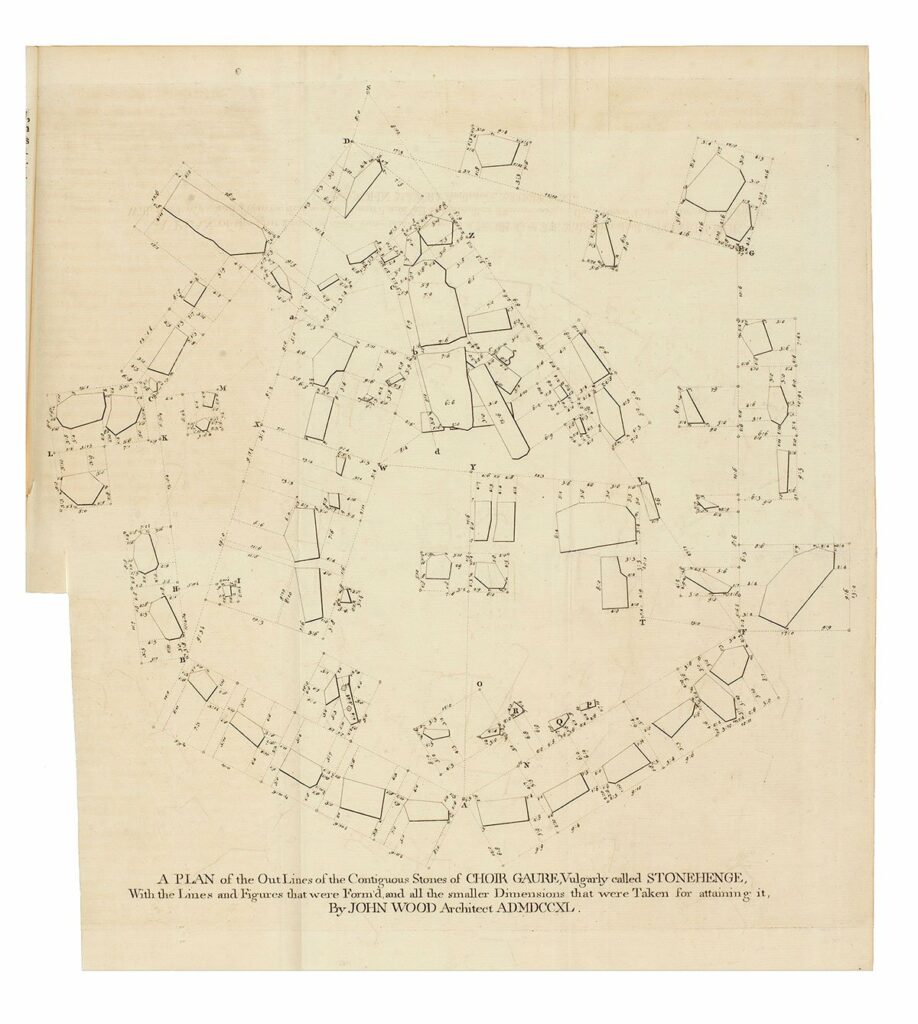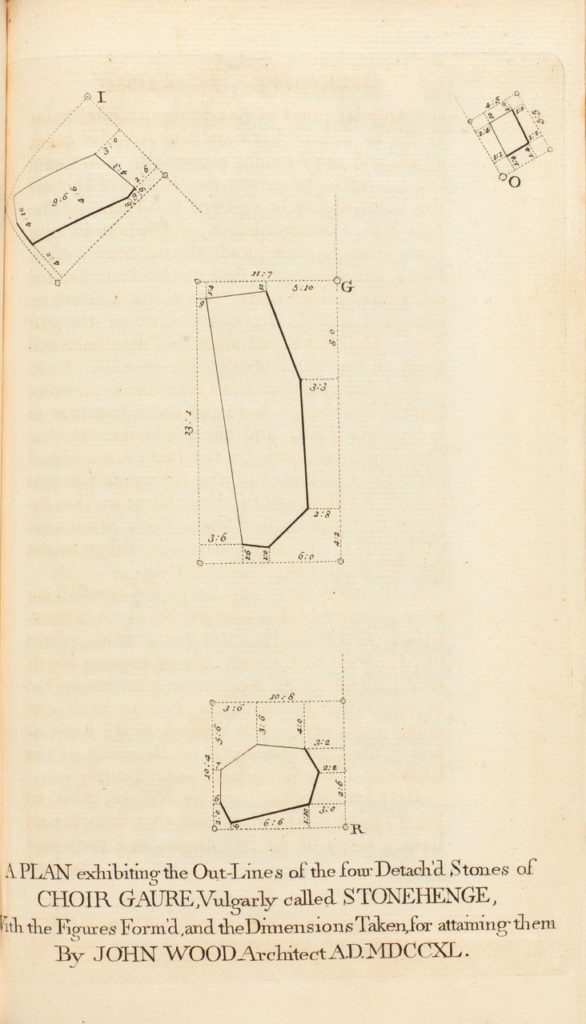Ugliness and Judgment

In the summer of 1740, John Wood the Elder ventured his first study of the lithic monuments that surrounded his native city of Bath, drawing sketches of the stones at Stanton Drew. These earned him the patronage of Edward Harley, second Earl of Oxford, which enabled Wood to undertake more deliberate surveys. These he carried out at the end of the same summer, first at Stanton Drew and then at Stonehenge. His study of Stanton Drew was the basis for the chapters in the Essay towards a Description of Bath, while the work on Stonehenge Wood published in 1747 as Choir Gaure, Vulgarly Called Stonehenge, on Salisbury Plain, Described, Restored, and Explained. With the latter publication, Wood joined a debate over the origins and significance of the megaliths that extended from Inigo Jones’s posthumously published survey and reconstruction, which he carried out for King James I in 1620, to the contrary arguments put forward by William Stukeley in 1740.[1] The axes of dispute were the authorship of the stone monuments – Roman according to Jones and Druidic according to Stukeley – and therefore their significance, pagan but imperial in Jones’s account and proto-Christian and trinitarian in Stukeley’s. Wood argued for their Druidic attribution, but with the origin of their architectural arrangement traceable, like that of Stanton Drew, to the divine architectural source of the Temple of Solomon.
But while Wood may have found himself in agreement with some parts of the accounts offered by other interpreters, he was quite clear that none was acceptable in full:
‘Though many have undertaken to Describe the Ruins of Stonehenge; to Restore those Ruins to their antient State; and, in general, to Explain the whole Work; Yet it is not Stonehenge that they have Described, Restored, or Explained to us, but a Work that never existed unless in their own Imaginations!’[2]
Wood also pointedly disagreed with Stukeley’s assertion that a minutely accurate survey of the stones was impossible and sought to refute it with the accomplishment of his own. Though his historical interpretation remained fantastical, Wood in his measurement and survey achieved a remarked fidelity to the physical reality of Stonehenge. Over the course of a few days, Wood set survey stakes around the site in arrangements of lines and polygonal figures in order to calculate with unprecedented precision the position and orientation of the stones. Over dozens of pages of his text, he rehearsed for his reader each of these survey lines and angles and noted, in additional scrupulousness, that he had left his survey stakes in place, driven down flush with the ground, should any person wish to check his measurements for error.[3] The contribution of Wood’s survey lay in this precision, as it provides still a knowledge of the disposition of the site as it lay in the eighteenth century.

The survey’s precision has a further significance, unremarked but relevant in the context of the emergence of a civic aesthetics: Wood’s precision arose in relation to his encounter with the irregularity of the stones themselves. Not only the overall arrangement but the shapes of the individual stones were understood to be deformations from some prior, more regular state. Though Wood disputed both Jones’s and Stukeley’s overly geometric reconstructions, he too imagined a more orderly form to have been the original condition. Yet he urged his reader to understand that even the prior Stonehenge was imperfect in this regard, conceding that ‘Perhaps Your Lordship will be surprized at the great Irregularity which appears in almost all the Pillars of the Work,’ but suggesting that an understanding of the difficulty of working such large stones set upon the ground, and of the effect of weather and vandalism over centuries changing those stones ‘from more regular Forms into the Shapes we now see them, it will very much abate our Ideas of Irregularity in the present Position of them’.[4] In an illustration of his technique for accurately ascertaining the profile of the stones, Wood published a drawing that showed the stones placed within rectangular frames, which he marked at the site with survey stakes and used as a norm to measure the offset dimensions of the existing stone. This illustration evokes the erosion of the surfaces over time while also establishing a theoretical proximity of the regular and the irregular. Not simply the original state of the stone in contrast to its present condition, but a simultaneous proximity, in Wood’s perspective, of an irregularity that is contained by and within a regularity; in more directly aesthetic terms, an ugliness encased within beauty.
‘The Body of Stonehenge, thus Restored to its perfect State, cant be conceived otherwise than as a most Beautiful, as well as a most Magnificent Structure.’[5] For Wood, as for Jones and Stukeley, the aesthetic presence of Stonehenge in its ruined state was a physical index for a prior presence that could be resummoned only through imagination and through techniques of representation. Wood disagreed with the others as to the arrangement and form of this prior presence, proposing a much less elaborate geometry to resolve the evidence of the stones as he found them into a coherent pattern of concentric rings. His restoration differs not only in its form but, most decisively, in Wood’s accompanying claim that his plan of Stonehenge in its perfect state represents the ‘State intended by the Architect of the Work’, even though the monument was never actually realised in this form.[6] The ‘Design was so far from being compleated, that I have many reasons to think the first Builders of Stonehenge did not Perfect so much as any one single part of the whole Fabrick,’ argued Wood, attributing the incompleteness of the monument not to contingency or accident, but proposing instead that it had been ‘purposely left unfinished’.[7] For Wood, then, Stonehenge existed in three states: the one he encountered during his survey; the ideal one planned by its architect; and a third, incomplete state between these two. It is Wood’s capacity to conceive of incompleteness as a positive condition that issues the most radical insight into the aesthetic presence of Stonehenge, for this conception collapses the otherwise sharp distinction between perfected form and ruined condition. Though Wood himself did not use the word ‘ugliness’, it is implicitly framed through his argument, not attached to the deformity of the ruin as a negation of beauty, but instead possessed of an instrumental, deliberate capacity, in the willful incompleteness of Stonehenge.
Wood arrived at his threefold view of Stonehenge only through the unique composite of an unconstrained historical imagination and a highly constrained technique of representation. It was through Wood’s encounter with Stonehenge as a reality that a framework for ugliness came into view. His conclusions were conditioned by the materiality and the actuality of the stones: their size, their weight, their surfaces. The irregularity of their abraded surfaces was made comprehensible, calculable, and representable by Wood’s survey points, lines, and measures. Wood’s undertaking to imagine the actual process used for the almost unimaginable labor of lifting the immense stones into place led him toward his reflections on incompleteness. His contemplation of the aesthetics of the stones was based not just upon a painterly view of Stonehenge in its setting, but also, and seemingly more, upon a close if speculative analysis of the color, crystallisation and geologic source of the stones. The sum of these different grapplings with the lithic actuality of Stonehenge was a representation that attempted to contain the excessive reality of the monument, an excessive reality that would itself be characteristic of an emerging conception of ugliness. With its careful study of the irregularity of the stones, and the decision to think historically about incompleteness, Wood’s investigation of Stonehenge introduced a substantively novel perspective on what would be two other constitutive dimensions of the aesthetic of ugliness: irregularity and incompleteness. Though the eccentricity of his theories often prompts their segregation, this novel perspective was not unrelated to the social and civic intentions of Wood’s own architectural work, for the aim of his historical efforts was to establish and legitimate a British origin to which that work might be bound. In fashioning a conceptual understanding of irregularity, incompleteness, and implacable materiality, Wood fashioned also a framework for the coexistence of ugliness and civic aesthetics.
This excerpt celebrates the publication of Ugliness and Judgment: On Architecture in the Public Eye, by Timothy Hyde, published by Princeton University Press, 2019
Notes
- Inigo Jones, The Most Notable Antiquity of Great Britain, Vulgarly Called Stone-Heng, on Salisbury Plain, Restored (London: James Flesher for Daniel Pakeman, 1655); William Stukeley, Stonehenge a Temple Restor’d to the British Druids (London: W. Innys and R. Manby, 1740).
- John Wood, Choir Gaure, Vulgarly Called Stonehenge, on Salisbury Plain, Described, Restored, and Explained (Oxford: J. Leake, 1747), 30.
- Ibid., 49.
- Ibid., 56–57.
- Ibid., 67.
- Ibid., 60.
- Ibid., 60, 62.

– Dijana O. Apostolski